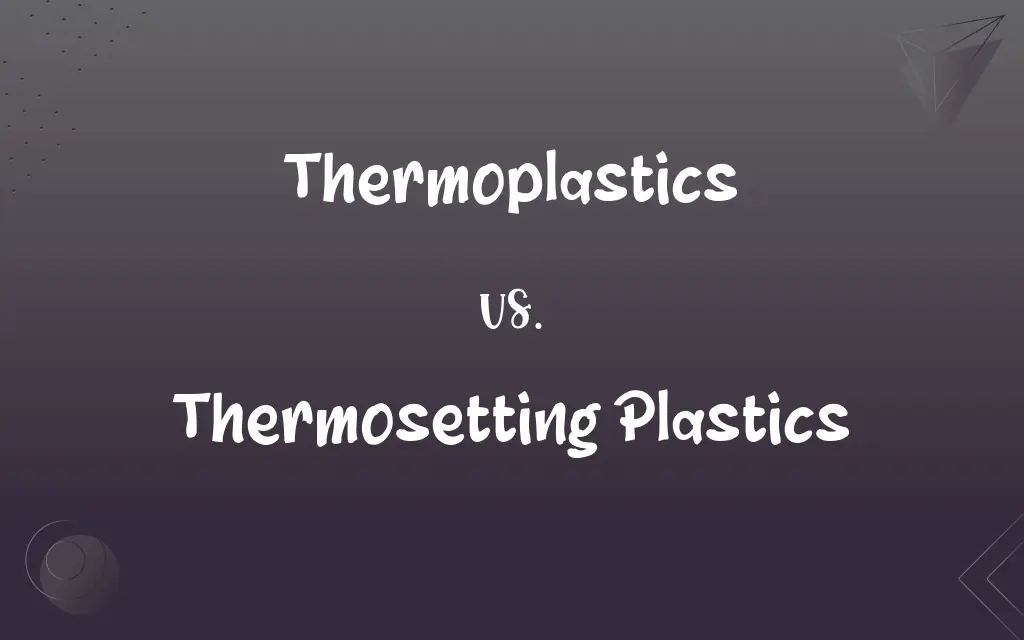Thermoplastics vs. Thermosetting Plastics: What's the Difference?
Edited by Janet White || By Harlon Moss || Updated on October 10, 2023
Thermoplastics can be reheated and reshaped multiple times, while thermosetting plastics once set, cannot be remelted or reshaped.

Key Differences
Thermoplastics, in the realm of polymers, boast a structure that permits them to soften upon heating and harden once cooled, this process is reversible and repeatable. Thermosetting plastics, alternatively, undergo an irreversible chemical change when heated, hardening permanently. There is a striking difference in how each material reacts to heat, thermoplastics soften, while thermosetting plastics do not.
In terms of molecular structure, thermoplastics exhibit a linear or slightly branched structure, allowing the polymer chains to melt and flow upon heating. Thermosetting plastics differentiate in that they have a heavily cross-linked structure which restricts mobility upon heating, preventing them from achieving a flowy molten state. This distinct molecular difference primarily marks the variance in their responses to heat.
Further, thermoplastics, due to their malleability and remoldability, find application in various industries such as packaging and consumer goods. On the contrary, thermosetting plastics are utilized in applications where rigidity and heat resistance are paramount, like in electrical fittings or adhesives, because once they’re set, they retain their shape and cannot be remolded or reshaped.
Recyclability is an aspect where thermoplastics have an edge as they can be melted and remolded repeatedly without significantly degrading the material’s quality. Thermosetting plastics cannot be recycled in a similar fashion due to their inability to be remolded upon heating, thereby posing a different set of challenges and opportunities in waste management.
In a nutshell, while thermoplastics offer flexibility, remoldability, and are generally more recyclable, thermosetting plastics offer enhanced stability, durability, and heat resistance, but sacrifice the ability to be remolded and reshaped.
ADVERTISEMENT
Comparison Chart
Word Count
One word
Two words
Syllables
Four syllables
Six syllables
Initial Letters
T (capitalized)
T and P (both words capitalized)
Use of Hyphen
No hyphen
No hyphen
Associated Adjectives
Often described as "remoldable" or "flexible"
Often described as "rigid" or "permanent"
ADVERTISEMENT
Common Abbreviations
Sometimes abbreviated as “TP”
Seldom abbreviated
Usage in Sentences
Typically used in contexts of reusable plastics
Used in contexts of once-set, hard plastics
Length of Words
14 characters
23 characters
Number of Vowels
4 vowels
6 vowels
Application in Industry
Widely used for everyday objects like containers
Commonly used for durable, heat-resistant items
Thermoplastics and Thermosetting Plastics Definitions
Thermoplastics
Thermoplastics usually have linear or slightly branched polymer structures.
Polyethylene, a type of thermoplastics, is used in numerous applications like plastic bags and containers.
Thermosetting Plastics
Once set, they retain their shape and cannot be reshaped or remolded, even upon reheating.
The casing, made of thermosetting plastics, maintained its shape despite exposure to heat.
Thermoplastics
Thermoplastics are polymers that become pliable or moldable when heated and harden upon cooling.
The bottle made of thermoplastics was easily remolded into a new shape after being heated.
Thermosetting Plastics
Thermosetting plastics are polymers that once cured or hardened, cannot be remelted or reformed.
The thermosetting plastics in the circuit board resist melting even under high temperatures.
Thermoplastics
They are characterized by their ability to undergo multiple cycles of melting and solidifying without undergoing significant degradation.
Thermoplastics are widely used in the packaging industry due to their recyclability.
Thermosetting Plastics
Thermosetting plastics are known for their high heat resistance and are often used in high-temperature applications.
Brake pads often contain thermosetting plastics to withstand high-temperature conditions.
Thermoplastics
Thermoplastics can be found in everyday items like plastic bags, containers, and toys due to their remoldability and cost-effectiveness.
The toys were manufactured using colorful thermoplastics to be durable and safe for children.
Thermosetting Plastics
They are composed of polymers that cross-link together during the curing process, forming an irreversible chemical bond.
Epoxy, a thermosetting plastics, is used in adhesives due to its strong, irreversible bond.
Thermoplastics
These polymers are known for their versatility and are used in various manufacturing processes like injection molding and extrusion.
Due to the malleability of thermoplastics, they are extruded into fibers or films.
Thermosetting Plastics
Thermosetting plastics find applications where a permanent shape, rigidity, and structural stability are required.
Thermosetting plastics are commonly found in electrical switches and outlets due to their insulating and heat-resistant properties.
Thermoplastics
Becoming soft when heated and hard when cooled.
Thermoplastics
A thermoplastic resin, such as polystyrene or polyethylene.
Thermoplastics
Plural of thermoplastic
FAQs
Are thermoplastics recyclable?
Yes, thermoplastics can be recycled since they can be melted and remolded multiple times.
Where are thermosetting plastics commonly used?
Thermosetting plastics are often used in electrical applications, adhesives, and some automotive parts.
What are thermoplastics?
Thermoplastics are polymers that can be melted and reshaped multiple times without undergoing a significant chemical change.
What defines thermosetting plastics?
Thermosetting plastics are polymers that, once molded and cured, cannot be remelted or reshaped.
Which is more heat-resistant, thermoplastics or thermosetting plastics?
Thermosetting plastics tend to have higher heat resistance compared to thermoplastics.
In what products might I encounter thermoplastics?
Thermoplastics are found in various products like plastic bottles, packaging, and toys.
Can you give an example of thermosetting plastic?
Epoxy resin is a widely recognized thermosetting plastic.
Why can’t thermosetting plastics be remelted?
The cross-linked polymer chains in thermosetting plastics form an irreversible chemical bond, preventing remelting.
Are thermosetting plastics used in electronics?
Yes, thermosetting plastics are commonly used in electronics due to their insulative and heat-resistant properties.
What makes thermoplastics suitable for recycling?
Their ability to melt and be reshaped without significant degradation makes thermoplastics suitable for recycling.
Can thermosetting plastics be used for making bottles?
Typically, thermosetting plastics are not used for bottles due to their rigidity and inability to be remolded.
Which is generally lighter, thermoplastics or thermosetting plastics?
Thermoplastics tend to be lighter, which is why they're often chosen for applications where weight is a critical factor.
What is the primary chemical structure of thermoplastics?
Thermoplastics generally have a linear or slightly branched chemical structure.
How are thermoplastics processed?
Thermoplastics can be processed using various methods like injection molding, extrusion, and blow molding.
Are thermosetting plastics commonly used in the automotive industry?
Yes, due to their heat resistance and durability, thermosetting plastics are used in various automotive components.
Can thermosetting plastics be recycled in a traditional manner?
No, thermosetting plastics cannot be remelted and hence, are not recyclable in a conventional sense.
What is an example of a thermoplastic?
Polyethylene is a common example of a thermoplastic.
Are thermoplastics or thermosetting plastics more durable?
While thermosetting plastics tend to have higher durability and stability, thermoplastics provide flexibility and ease of processing.
Which is more cost-effective to produce, thermoplastics or thermosetting plastics?
Thermoplastics are typically more cost-effective due to their ease of production and recyclability.
What are the environmental impacts of using thermoplastics?
While thermoplastics can be recycled, improper disposal and single-use items contribute to environmental pollution.
About Author
Written by
Harlon MossHarlon is a seasoned quality moderator and accomplished content writer for Difference Wiki. An alumnus of the prestigious University of California, he earned his degree in Computer Science. Leveraging his academic background, Harlon brings a meticulous and informed perspective to his work, ensuring content accuracy and excellence.
Edited by
Janet WhiteJanet White has been an esteemed writer and blogger for Difference Wiki. Holding a Master's degree in Science and Medical Journalism from the prestigious Boston University, she has consistently demonstrated her expertise and passion for her field. When she's not immersed in her work, Janet relishes her time exercising, delving into a good book, and cherishing moments with friends and family.































































